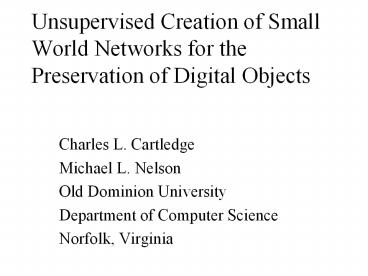A Framework for Digital Object Self-Preservation - PowerPoint PPT Presentation
1 / 20
Title:
A Framework for Digital Object Self-Preservation
Description:
Unsupervised Creation of Small World Networks for the Preservation of Digital Objects Charles L. Cartledge Michael L. Nelson Old Dominion University – PowerPoint PPT presentation
Number of Views:96
Avg rating:3.0/5.0
Title: A Framework for Digital Object Self-Preservation
1
Unsupervised Creation of Small World Networks for
the Preservation of Digital Objects
Charles L. Cartledge Michael L. Nelson Old
Dominion University Department of Computer
Science Norfolk, Virginia
2
Order of Presentation
- Technology enablers
- Constraints
- Simple rules for Complex Behavior
- Simulation approach
- Simulation results
- Future work
3
Motivation
4
Technology Enablers
Cost data http//www.archivebuilders.com/whitepap
ers/22011p.pdf
5
Constraints
6
Reynoldss Rules for Flocking
- Collision Avoidance avoid collisions with nearby
flock mates - Velocity Matching attempt to match velocity with
nearby flock mates - Flock Centering attempt to stay close to nearby
flock mates
Images and rules http//www.red3d.com/cwr/boids/
Doctoral Consortium
6
7
Types of Graphs
(Each graph has 20 vertices and 40 edges.)
8
Desirable Graph Properties
9
Unsupervised Small World Graph Creation
- gamma 0.0
- alpha 0.99
- gamma 0.7
- alpha 0.99
- 0.2 lt beta lt0.66
- gamma lt 0.6
CC is shown as dark lines L is shown as light
lines
10
Phases/Activities
11
Creation
Any DO
12
Wandering
A
B
D
C
13
Connecting
A
B
D
C
14
Flocking
A
A
A
A
15
Typical Simulation Parameters
- alpha 0.5
- beta 0.6
- gamma 0.1
- Number of DOs 1000
- Number of hosts 1000
- Min number desired replicas 3
- Max number desired replicas 10
- Max number of replicas per host 20
16
Simulation Results and Analysis
17
Future work
- Test the autonomous graphs for resilience to
error and attack - Test what happens when a graph becomes
disconnected - Test what happens when a disconnected graph
becomes re-connected
18
Conclusions
- We have shown that Digital Objects can
autonomously create small world graphs based on
locally gleaned data - These graphs can be used for long term
preservation - We intend to study these graphs focusing on their
tolerance to isolated and widespread failures
19
And that concludes my presentation.
20
Backup Information
- Equations for Average Path Length and Clustering
Coefficients































